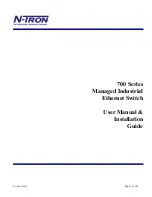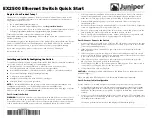
User’s Manual
7
2. G
ETTING
S
TARTED
This chapter describes the RCM4000 hardware in more detail, and
explains how to set up and use the accompanying Prototyping Board.
NOTE:
This chapter (and this manual) assume that you have the RCM4000 Development
Kit. If you purchased an RCM4000 module by itself, you will have to adapt the infor-
mation in this chapter and elsewhere to your test and development setup.
2.1 Install Dynamic C
To develop and debug programs for the RCM4000 (and for all other Rabbit Semiconductor
hardware), you must install and use Dynamic C.
If you have not yet installed Dynamic C version 10.03 (or a later version), do so now by
inserting the Dynamic C CD from the RCM4000 Development Kit in your PC’s CD-ROM
drive. If autorun is enabled, the CD installation will begin automatically.
If autorun is disabled or the installation does not start, use the Windows
Start | Run
menu
or Windows Disk Explorer to launch
setup.exe
from the root folder of the CD-ROM.
The installation program will guide you through the installation process. Most steps of the
process are self-explanatory.
Dynamic C uses a COM (serial) port to communicate with the target development system.
The installation allows you to choose the COM port that will be used. The default selec-
tion is COM1. You may select any available port for Dynamic C’s use. If you are not cer-
tain which port is available, select COM1. This selection can be changed later within
Dynamic C.
NOTE:
The installation utility does not check the selected COM port in any way. Speci-
fying a port in use by another device (mouse, modem, etc.) may lead to a message such
as
"could not open serial port"
when Dynamic C is started.
Once your installation is complete, you will have up to three new icons on your PC desk-
top. One icon is for Dynamic C, one opens the documentation menu, and the third is for
the Rabbit Field Utility, a tool used to download precompiled software to a target system.
If you have purchased any of the optional Dynamic C modules, install them after installing
Dynamic C. The modules may be installed in any order. You must install the modules in
the same directory where Dynamic C was installed.
Summary of Contents for RabbitCore RCM4000
Page 6: ...RabbitCore RCM4100...
Page 12: ...6 RabbitCore RCM4000...
Page 20: ...14 RabbitCore RCM4000...
Page 46: ...40 RabbitCore RCM4000...
Page 68: ...62 RabbitCore RCM4000...
Page 82: ...76 RabbitCore RCM4000...
Page 96: ...90 RabbitCore RCM4000...
Page 114: ...108 RabbitCore RCM4000...
Page 118: ...112 RabbitCore RCM4000...
Page 122: ...116 RabbitCore RCM4000...
Page 124: ......














































